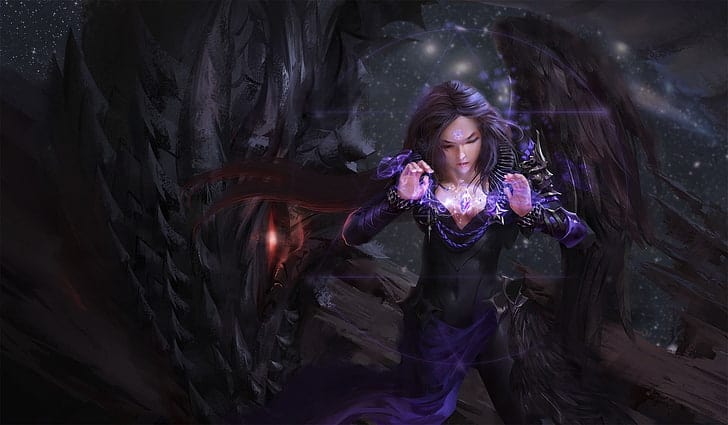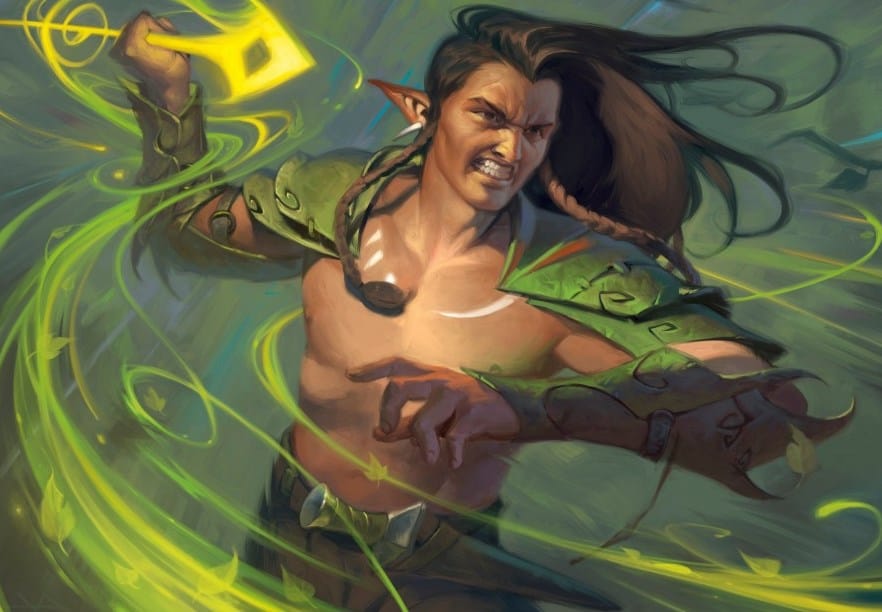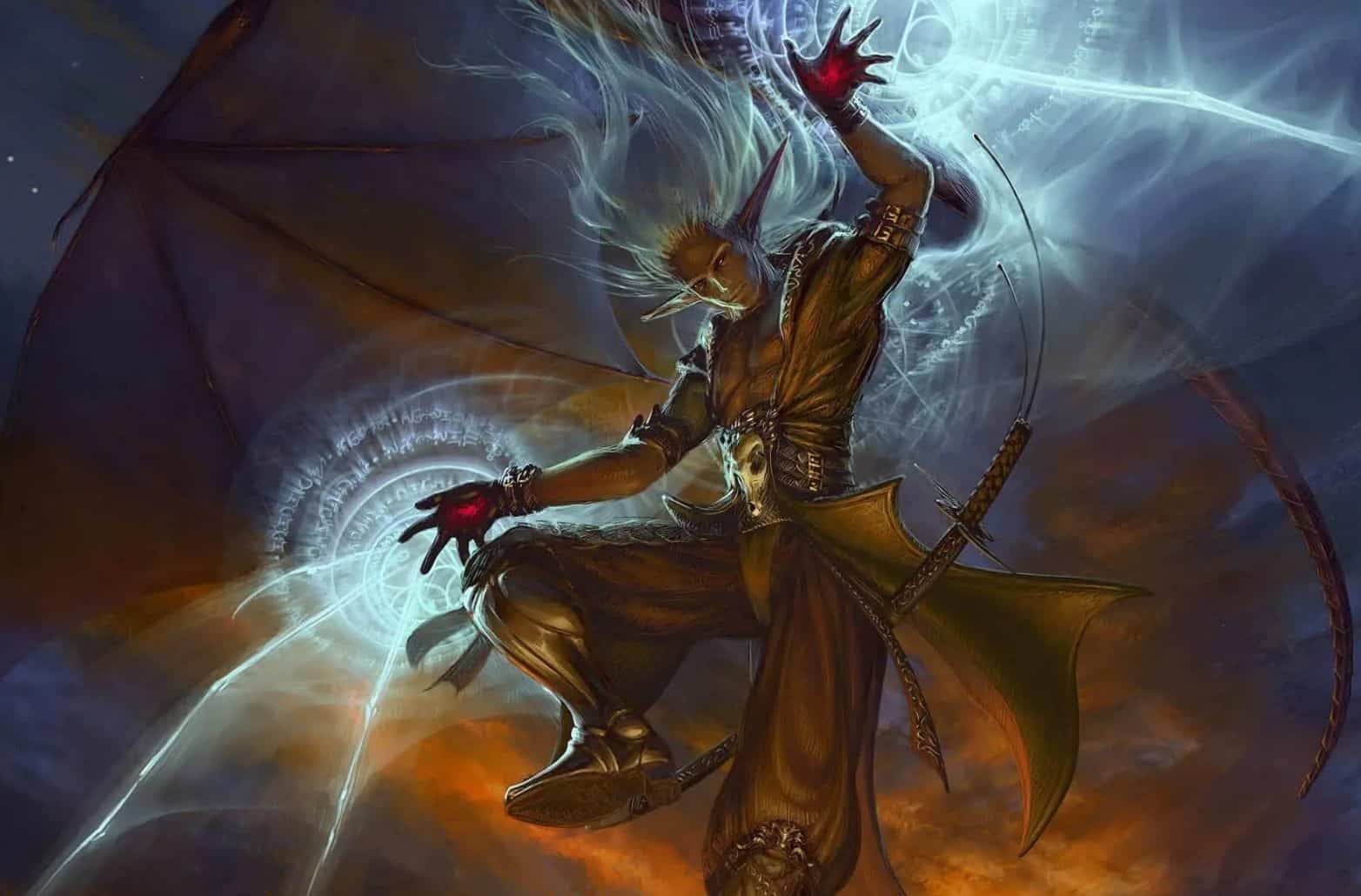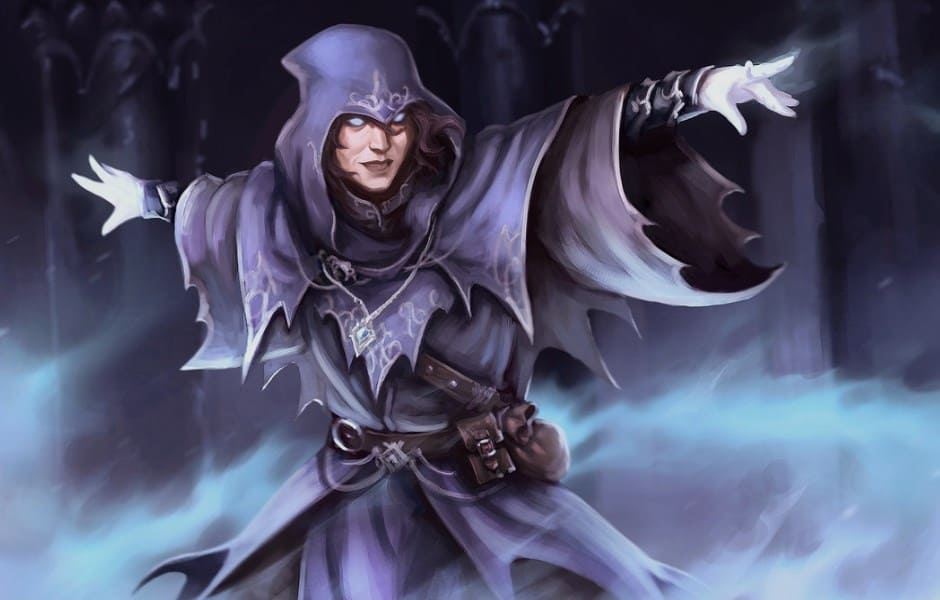The ‘innate’ spellcasters of Dungeons & Dragons, Sorcerers are a great D&D class for both beginner D&D players to veteran gamers. As rare magic-users in the world of D&D, Sorcerers are an appealing class for many.
In this Sorcerer 5e guide, we’ll cover everything you need to know about playing a Sorcerer in 5e, including:
- What are Sorcerers in 5e?
- How to create a Sorcerer
- Sorcerous Origins
- Sorcerer spells
- Frequently asked questions
What are Sorcerers in 5e?

With a crack of lightning, a gust of cold wind, and an icy beam of light, the Sorcerer emerges from the shadows with her eyes glowing. The first Sorcerer in her family for hundreds of years, she is a rare mixture of innate magic and unpredictable chaos.
Whether her power stems from her draconic ancestors or from the wild magic that formed the world, all those who meet her know that her power is ancient and terrifying.
Sorcerers have been a playable class in D&D since the 3rd edition. They did not study to learn magic nor do they need spellbooks. Instead, magic is a part of who they are. Sorcerers are very rare and can play many roles in a party – from a deadly opponent in combat to an essential buff for other party members.
Sorcerers are also one of the easiest spellcasting classes in D&D 5e. Despite being easier to play than Wizards or Warlocks, Sorcerers are an exciting and rewarding character class.
How to create a Sorcerer
Sorcerer statistics
The Sorcerer’s primary statistic in 5e is Charisma. If you want to play a Sorcerer, Charisma should be your highest stat, followed by Constitution.
Sorcerer characteristics
- How many hit points do Sorcerers get?
At 1st level, Sorcerers get 6 hit points plus their Constitution modifier. After 1st level, Sorcerers get an additional d6 per level worth of hit points. - What armor can Sorcerers wear?
Sorcerers can wear any armor but they do not have any armor proficiencies. - What weapons can Sorcerers use?
Sorcerers have proficiency with daggers, darts, slings, quarterstaffs, and light crossbows. - What saving throws are Sorcerers proficient in?
Constitution and Charisma. If your Dungeon Master asks you to do a saving throw, you will usually do it with the modifier from either Constitution or Charisma. - What skills do Sorcerers have?
When you create a Sorcerer character in 5e, you can choose two skills from the following: Arcana, Deception, Insight, Intimidation, Persuasion, and Religion. - What equipment do Sorcerers start with?
All characters in D&D 5e have starting equipment. Sorcerers start with: a light crossbow and 20 bolts OR any simple weapon; a component pouch OR an arcane focus; a dungeoneer’s pack OR an explorer’s pack; and two daggers. - What special abilities do Sorcerers have?
Sorcerers’ primary ability is their spellcasting, which we’ll explain further below. As they level up, however, Sorcerers gain additional special abilities in relation to their magic. These are:- 1st level: Sorcerers know four cantrips of their choice
- 2nd level: Font of magic – Sorcerers at 2nd level and above have sorcery points which can be used for gaining extra spell slots and, from 3rd level, casting metamagic.
- 3rd level: Metamagic – From the 3rd level, Sorcerers can use sorcery points to alter spells to suit their needs. At 3rd level, Sorcerers choose two of the following Metamagic abilities, and gain another one at 10th and 17th level:
- Careful spell: When you cast a spell that forces a saving throw, spend 1 sorcery point to choose a number of creatures equal to your Charisma modifier. Those creatures automatically pass their saving throw.
- Distant spell: Spend 1 sorcery point to double the range of a spell that already has a range of 5ft or more.
- Empowered spell: If you cast a spell that deals damage, spend 1 sorcery point to re-roll damage dice equal to your Charisma modifier.
- Extended spell: If you cast a spell with a duration of 1 minute or more, you can spend 1 sorcery point to double the duration of the spell.
- Heightened spell: When you cast a spell that forces a saving throw, you can spend 3 sorcery points give one target of the spell disadvantage on its saving throw roll.
- Quickened spell: You can spend 2 sorcery points to change the casting time of a 1 action spell to a bonus action instead.
- Subtle spell: If you spend 1 sorcery point, you can cast a spell without having to perform the verbal or somatic components.
- Twinned spell: By spending sorcery points equal to the spell’s level, you can make a spell that targets one creature target two instead. Cantrips cost 1 sorcery point.
- 4th level: Ability score improvement – at 4th, 8th, 12th, 16th, and 19th level, Sorcerers can either increase one ability score by 2 or two ability scores by 1.
- 20th level: Sorcerers at 20th level regain 4 sorcery points after a short rest.
Sorcerous Origins

Sorcerers have innate magic and claim various origins for it. In The Dungeons & Dragons Player’s Handbook, there are two options for your Sorcerous Origin: Draconic Bloodline and Wild Magic.
Draconic Bloodline
Sorcerers with the Draconic Bloodline origin are the descendants of those whose blood was mixed with draconic magic. Some Sorcerers claim to be descended from a powerful ancestor who made a pact with a dragon for his magic, whilst others may even claim they have dragon ancestors. Other sorcerers are the first of their line, perhaps because they too made a pact with a dragon.
The Draconic Bloodline gives Sorcerers several special abilities. Here they are broken down by level:
- 1st level: Dragon Ancestor – Choose a type of dragon as your ancestor from the following (damage type in brackets):
- Black (acid)
- Blue (lightning)
- Brass (fire)
- Bronze (lightning)
- Copper (acid)
- Gold (fire)
- Green (poison)
- Red (fire)
- Silver (cold)
- White (cold)
- At 1st level you can also read, write, and speak Draconic. In addition to this, whenever you must make a Charisma check when interacting with a dragon, your proficiency bonus is doubled if applied to the check.
- 1st level: Draconic Resilience – The physical qualities of your dragon ancestor make you stronger. At each level, including a level 1, your hit points maximum increases by 1. Additionally, when you are not wearing armor your AC is 13 plus your Charisma modifier.
- 6th level: Elemental Affinity – If you cast a spell that deals the same damage as that of your dragon ancestor, your Charisma modifier are added to the damage. You can also spend a sorcery point to gain resistance to that type of damage for 1 hour.
- 14th level: Dragon Wings – You can sprout dragon wings from your back and fly (your flying speed is equal to your walking speed). You cannot sprout wings if you are wearing armor unless the armor is made specifically for them.
- 18th level: Draconic Presence – You can channel the presence of your dragon ancestor, which causes those around you to become awestruck or frightened. This can be done by spending 5 sorcery points as action and choosing to exude an aura of awe or fear to all those within 60ft of you. Hostile creatures who fail a Wisdom saving throw will either be charmed (awe) or frightened (fear) until the aura ends. Draconic Presence lasts for 1 minute or until your concentration breaks.
Wild Magic

Sorcerers who choose Wild Magic as their sorcerous origin have innate magic from the wild and chaotic forces that created the world. Some of these sorcerers were exposed to Wild Magic whilst in another plane or a distant realm. Others were given this magic by a fey creature or a demon. And a small number of sorcerers were born with Wild Magic.
Sorcerers with Wild Magic have several special abilities. Here they are broken down by level:
- 1st level: Wild Magic Surge – After casting a sorcerer spell of 1st level or higher, the Dungeon Master can ask you to roll a d20. If you roll a 1, a random magic effect happens. This is determined by rolling a d100 and checking the number against the Wild Magic Surge Table, which can be found in The Player’s Handbook.
- 1st level: Tides of Chaos – Once in between long rests, Wild Magic Sorcerers can gain an advantage on one attack roll. If, after using Tides of Chaos already, the Dungeon Master asks you to roll on the Wild Magic Surge Table, you regain your Tides of Chaos ability immediately.
- 6th level: Bend Luck – If a creature you can see makes an attack roll, an ability check, or a saving throw roll, you can use your reaction to spend 2 sorcery points to twist fate. When you do this, you roll 1d4 and apply the number rolled as a bonus or penalty (your choice) to the creature’s roll.
- 14th level: Controlled Chaos – Whenever you roll on the Wild Magic Surge Table, you can roll twice and choose between the numbers.
- 18th level: Spell Bombardment – Once per turn, if you roll damage for a spell and roll the highest number possible on any dice, you can re-roll those dice and add that number to the total damage.
Alternative Sorcerous Origins

There are plenty of alternative Sorcerous Origins found outside of the original two in the Player’s Handbook. Other Origins developed elsewhere are:
- Tasha’s Cauldron of Everything:
- Aberrant Mind – An alien influence has granted you psionic powers, allowing you to touch the minds of others and alter the world around you.
- Clockwork Soul – A plane of existence rooted in clockwork efficiency, such as Mechanus, has infused you with the power of order.
- Xanathar’s Guide to Everything:
- Divine Soul – A divine being has instilled you with magic, allowing you to learn spells usually associated with the Cleric class.
- Shadow – Your magic comes from Shadowfell, the dark plane of shadow. This gives you many strange and dark features and spells.
- Storm – You draw your power from elemental air, giving you power over the weather and storms.
What are the Sorcerer spells in 5e?
Sorcerers are instilled with arcane magic. As ‘innate’ spellcasters, Sorcerers do not need spellbooks, nor do they need to ‘prepare’ spells as Wizards do. Instead, Sorcerers ‘know’ a certain number of spells at each level and regain their spell slots when they take a long rest. At 1st level, Sorcerers know four Sorcerer cantrips and two 1st level Sorcerer spells. As you level up, you will get access to more spells and more spell slots.
What are the Sorcerer cantrips?

Cantrips are a special type of spell that can be cast at any time, without the need to prepare them. Cantrips have a spell level of 0. The cantrips you can choose from at 1st level are:
- Acid Splash: You throw a bubble of acid at one creature within range or two creatures within range that are less than 5ft apart. If the target fails a Dexterity saving throw they take 1d6 acid damage.
- Blade Ward: By tracing a sigil of protection in the air in front of you, you are resistant to bludgeoning, piercing, and slashing damage dealt by weapons until the end of your next turn.
- Chill Touch: You create a ghostly, skeletal hand in front of a creature within 120ft. On a successful ranged attack, the target takes 1d8 necrotic damage and cannot regain health until the start of your next turn. When used against undead creatures, the target has a disadvantage on attack rolls against you until the start of your next turn.
- Dancing Lights: You can create up to four torch-sized glowing lights. These appear as beams, orbs, or they can be combined to make a humanoid-shaped light.
- Fire Bolt: As a ranged attack, you can throw a mote of fire at a target. If the attack is successful, that target takes 1d10 fire damage.
- Friends: For 1 minute, you have an advantage on all Charisma checks directed at a non-hostile creature of your choice. When the spell ends, the creature will realize you used magic on it and become hostile and potentially violent.
- Light: An object you touch emits bright light in a 20ft radius.
- Mage Hand: You create a floating hand, which appears within 30ft of you. This can be used to manipulate objects – such as opening doors or lifting small objects.
- Mending: You can repair a single break or tear (no more than 1ft in its dimension) in an object that you touch.
- Message: A creature within 120ft of you can hear a message that you whisper and reply back to you.
- Minor Illusion: You create a sound or image within 30ft for 1 minute. If you create an image, it cannot be larger than a 5ft cube. If a creature examines the object, they can realize it is an illusion if they succeed on an Intelligence check against your spell save DC (difficulty class).
- Poison Spray: You can target a nearby creature with a puff of poisonous gas. That creature must make a Constitution test and, if they fail, take 1d12 poison damage.
- Prestidigitation: You create one of the following magical effects within 10ft of you:
- A harmless sensory effect such as an odor, quiet music, a puff of wind, or a brief spark.
- You can light or extinguish a candle, torch, or small campfire.
- You can clean or soil an object no larger than 1 cubic square foot.
- You can make a color, symbol, or mark appear on an object for 1 hour.
- Ray of Frost: You create a beam of cold, blue light that will hit a creature in range on a successful ranged attack. The target will take 1d8 cold damage.
- Shocking Grasp: Using a melee attack, you can shock a creature with lightning. Your attack roll will have an advantage if the target is wearing metal armor. If hit, the target takes 1d8 lightning damage and won’t be able to react until the start of its next turn.
- True Strike: By pointing at a target within 30ft, you gain insight into their defenses. On your next turn, you have an advantage on your first attack roll against that target.
What is the best 1st level Sorcerer spells in 5e?

Sorcerers have access to lots of great spells at 1st level, but they can only ‘know’ two. The two spells you choose at 1st level are somewhat dependent on the role you want to play within your party (do you want to be a combat-heavy sorcerer or are you more interested in illusion magic?). Either way, here are the best 1st level spells to consider:
- Charm Person: You can charm a humanoid within range if they fail a Wisdom saving throw. The charmed creature will see you as a friendly acquaintance, but they will know they were charmed when the spell ends.
- Mage Armor: If you touch a willing creature who isn’t wearing armor, their AC becomes 13 plus their Dexterity modifier. The spell ends if the creature put on armor, if you dismiss the spell, or after 8 hours.
- Magic Missile: You create three magical darts that can each be fired at a creature you can see of your choice (within 120ft). Each dart deals 1d4+1 force damage.
- Sleep: Roll 5d8 – the result will tell you the combined number of hit points worth of creatures you can put into a magical slumber with this spell. This spell does not work against undead or any creature immune to charm.
Frequently Asked Questions
Question: Can you use multiple Metamagic options on one spell?
Answer: No – you usually cannot use multiple Metamagic options on one spell. There is one exception to this rule, however. An empowered spell can be used on a spell that has already received a Metamagic option during the casting of the spell.
Question: What is the Sorcerer’s spellcasting ability in 5e?
Answer: Charisma – Whenever a spell refers to your spellcasting ability, you use your Charisma modifier. Your Charisma modifier is also used for your spell save DC and your spell attack modifier.
Question: What do Sorcerers use as a spellcasting focus?
Answer: Sorcerers use an arcane focus as a spellcasting focus for Sorcerer spells. This is a special item such as an orb, rod, crystal, staff, or wand designed to channel the power of arcane spells. Any arcane spell that has a Material (M) component requires an arcane focus.
Question: What are the best cantrips for Sorcerers?
Answer: Message, Mage Hand, and Light are both very helpful cantrips to have on hand. They can make things easier for the whole party. Chill Touch is also a great cantrip in combat.
Final thoughts on Sorcerers in 5e
Sorcerers are an exciting and rewarding class to play as in D&D 5e. Their spellcasting is relatively simple but it can become incredibly powerful.
If you are thinking of playing a Sorcerer, you may want to pick up some Arcane Spellbook Cards. These will make it easier and quicker to check how your spells work without having to flick through rulebooks!
- Best Alternatives to Dungeons & Dragons - August 23, 2023
- Wyverns 5e Guide: The Chickens of the Dragon Family - September 5, 2022
- Best DnD Dice Tray Ideas for Players and DMs - August 22, 2022

